MSi GeForceFX 5700TD Ultra Review
MSi GeForceFX 5700TD Ultra
MSi is attacking the mid-range graphics card market with this FX5700 Ultra based offering.
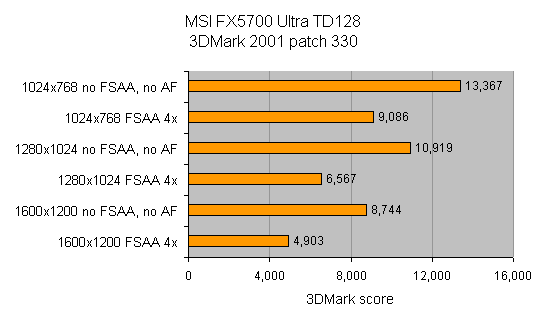
Verdict
Key Specifications
- Review Price: £150.00
There’s no better time to release a product than for the Christmas season, so it was no surprise when graphics masters nVidia and ATi both announced new GPUs for the end of 2003. Each of these was aimed at the middle tier of the graphics market with ATi offering the 9600XT and nVidia launching the GeForceFX 5700 series. While the high performance cards grab the headlines, it’s the affordable cards that keep the cash tills ringing.
ATi has already laid out its stock with the Radeon 9600XT and the Asus branded board I looked at last month delivered an impressive debut. The card I’m looking at here is from MSi and is based on nVidia’s GeForceFX 5700 Ultra GPU, codenamed NV36. This draws on the improvements introduced with nVidia’s GeForceFX 5950 series. The primary of these is that the GeForceFX 5700 series is manufactured using a 0.13 Micron process. This enables the clock speed to be set at a hefty 475MHz. It’s worth noting that this speed is only delivered when the 3D pipelines are in use – in 2D the core speed automatically drops down to 300MHz.
Now that the technology has matured and prices have dropped, nVidia has revisited DDRII for its memory, with 128MB included on the board. It’s rated at 450MHz giving an effective clock of 900MHz, which is remarkable for a card at this price. This ensures that the card has much more memory bandwidth available to it than the underwhelming 5600 series, with a decent 14.4GB/sec to play with. This isn’t too far off the 16GB/sec that the GeForceFX 5800 Ultra offered a year ago and is important for smoothly running image quality enhancements such as anti-aliasing. With clock speeds so high, the major difference with the current top of the range GeForceFX 5950, is that the interface to the memory is 128bit rather than 256bit.
The 5700 Ultra also benefits from architectural improvements drawn from the GeForceFX 5950, in the form of the CineFX 2. This includes support for pixel and vertex shader programs of up to 1,024 instructions as well as superior performance. This will enable greater precision over how game developers can manipulate pixels and will lead to better effects. The use of shaders in games is not common yet but will be increasingly used in new games over the next year.
The 5700 series also uses the UltraShadow technology introduced with the 5900 series, and the Intellisample HCT (high-resolution compression technology) for improved anti-aliasing.
When the GeForceFX series was first introduced it suffered from extremely noisy and cumbersome cooling solutions. However this MSi card demonstrates how the GeForceFX line has matured. The heatsink has a sizable fan that’s as quiet as I’ve ever heard from an out-of-the-box solution, with the packaging stating that it will run no louder than 28db. Unlike the top of the line GeForceFX 5950, the card also occupies a single slot and fits comfortably in a Shuttle based PC. Like the 5950 however, it does require a second power connector, though you can install the card and boot Windows without it – the card will only complain when you try to launch a 3D application.
As is now standard, this card features dual outputs with DVI and D-SUB connections. It also features a TV-Out. When testing this I found that the picture wasn’t as sharp as that of an ATi Radeon 8500DV used for reference. I was also disappointed that the nVidia drivers wouldn’t enable me to have the TV-out working at the same time as the D-SUB – it was either one of the other.
The crucial factor though is performance. Here it seems that for the first time in a long while, nVidia has got it right. In all our game-based benchmarks the MSi outpaced the Asus 9600XT TVD. At Unreal Tournament 2003, a game that uses a mixture of Direct X 7 and 8 effects, the nVidia based card won out at a resolution of 1,600 x 1,200 with 4x anti-aliasing and 4x anisotropic filtering, with 37fps to the 9600XT’s, 26fps. The same was true in the other tests, with 40.6fps to the 9600XT’s 32fps at Serious Sam.
However the jury is still out on DirectX 9 games. In the synthetic 3DMark03 benchmarks, which are weighted heavily on DirectX 9 performance, the GeForceFX 5700 Ultra scored only 3180 to the 9600XT’s 3644. Conversely it was faster at the DirectX 7 based 3DMark 2001. The only game benchmark we tested with that uses DirectX 9 is Gun Metal but this is written using the nVidia created CG language rather than the DX9 standard HLSL. As I expected the MSi outperformed the 9600XT.
We are currently in the process of updating our graphics card tests and will hopefully have a wider range of real game benchmarks soon with which to test future cards.
If you want to squeeze more out of your card, you can use the overlooking utility buried away on one of the numerous CDs included with the card. Unfortunately though, rather than a simple application it sports an absurd Macromedia Flash based virtual 3D interface in a web browser. However, it does enable you to increase the core clock and memory speeds. MSi also offers a thermal protection facility so you don’t have to worry about melting your card, while there’s also a useful auto update tool for obtaining the latest drivers and BIOS updates.
With a number of manufacturers offering cards, MSi adds some extras to its package. Unfortunately these aren’t worth getting too exited about. The three full games included are Morrowind, Ghost Recon and Duke Nukem: Manhattan Project, but these aren’t as appealing as the Half Life 2 voucher included with the Radeon 9600XT cards. There is however, a full 5.1 channel version of WinDVD included.
As a package the MSi is a good card, based on an impressive chip and memory architecture. It makes it possible to play recent games at resolutions as high as 1,280 x 1,024 with some image quality enhancements. I also tried Deus Ex 2, a recent title and found that for very smooth frame rates with 4x AA and 4xAF enabled resolution I had to drop to 800 x 600.
This card is a good performer and the package is reasonable. For DX9 performance ATi still has the edge, but on the whole the MSi GeForceFX 5700TD Ultra is a solid mid-range card.
”’Verdict”’
If you’re after an affordable graphics card to handle current games the MSi GeForceFX 5700TD Ultra definitely fits the bill.

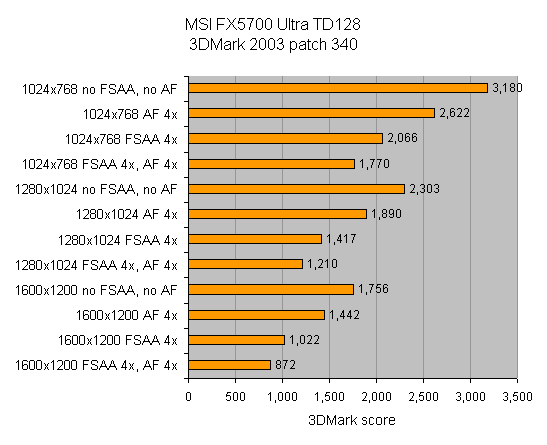
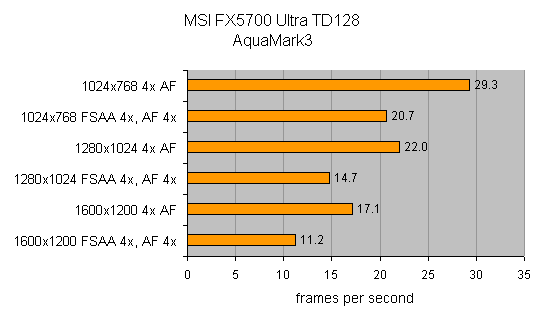
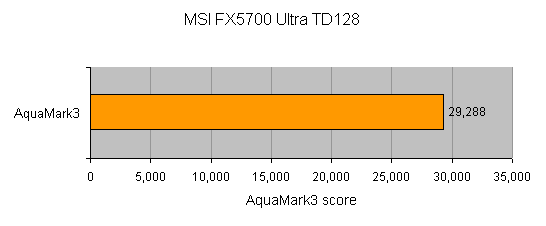
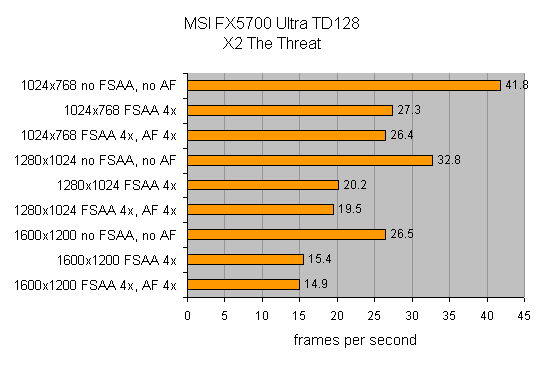
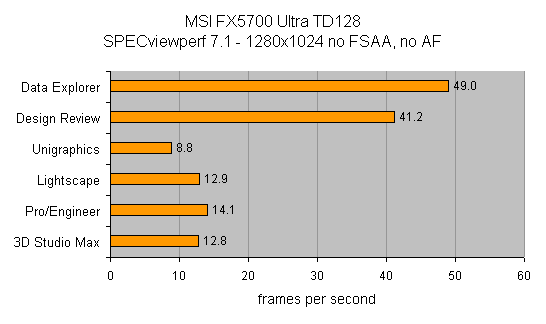
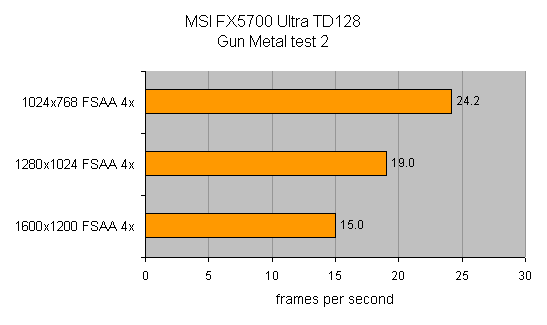
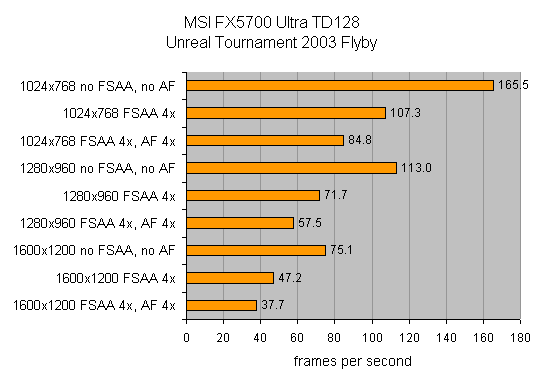
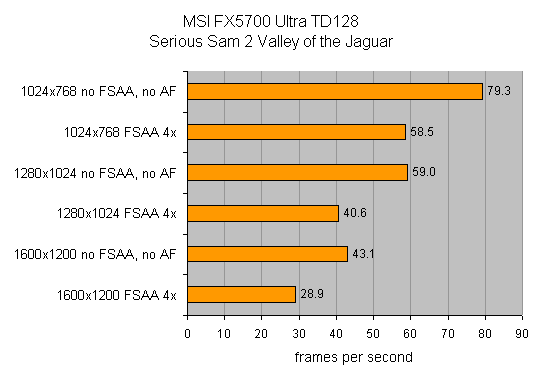
Trusted Score
Score in detail
-
Value 9
-
Features 8
-
Performance 8

